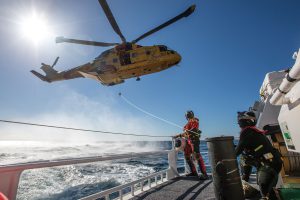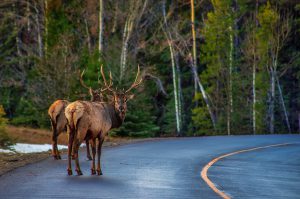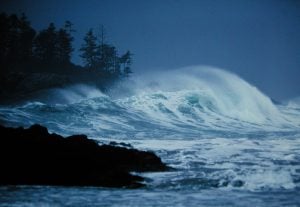
People & Culture
Safety first, service always: The Canadian Coast Guard turns 60
A celebration of the Canadian Coast Guard’s renowned search-and-rescue capabilities — and more — as the special operating agency turns 60
- 4392 words
- 18 minutes
Travel
Freedom is wide open spaces framed by endless skies and rich history. It is uncrowded, quiet, calm and yours to define in the Cariboo Chilcotin Coast.

Follow in the footsteps of the past and connect with nature in British Columbia’s spectacular and awe-inspiring Cariboo Chilcotin Coast region. This land without limits is home to four unforgettable road trip routes. Revisit history on the Cariboo Gold Rush Trail; explore B.C.’s Land of Hidden Waters; venture into the Chilcotin via Highway 20; then travel down Heckman Pass into the Great Bear Rainforest on B.C.’s central coast. No matter which route you choose, the people, adventures and experiences in the Cariboo Chilcotin Coast will linger long in your memory.
For the intrepid explorer eager to retrace history, the historic Cariboo Gold Rush Trail follows the path of gold seekers searching for their fortune in the wilds of British Columbia.
Cariboo country is bisected by Highway 97 and stretches from Cache Creek in the south to Hixon and Stoner in the north. The region was named after the once abundant woodland caribou and was the first part of the B.C. Interior to be settled by non-Indigenous people.
The Gold Rush of the 1860s brought adventurers from all corners of the world. Evidence of that boisterous heritage remains, with pioneer cabins and homesteads all along the Gold Rush Trail including Barkerville Historic Town & Park, a National Historic Site.
A living museum and final stop on the Cariboo Waggon (yes, two g’s!) Road, Barkerville’s legends and stories of the Cariboo Gold Rush are brought back to life each summer in fine 19th century detail.
The outsized history of this place is matched by landscapes that range from a rare inland rainforest and mountain lakes to rolling grasslands, semi-dry deserts and arid, lava-formed canyons.

The Gold Rush Trail is where you can find two of this region’s natural wonders. With a maximum depth of over 500 metres, Quesnel Lake is the deepest lake in B.C. and perfect for fishing huge rainbow trout or exploring by boat, canoe, or paddleboard.
Stop at Cariboo Mountains Provincial Park, home to the only inland temperate rainforest in North America. Here, more than 500 kilometres from the coast, endangered caribou feed on arboreal (tree-growing) lichens found in the old-growth forest.
Some of British Columbia’s best-kept secrets await in the Land of Hidden Waters, a place of roaring waterfalls, glittering lakes and streams, and some of the best freshwater fishing in the country.
This region is encircled by four scenic highways: take the Trans-Canada Highway west from Kamloops to Cache Creek, then head north on Highway 97 to 93 Mile. Or, take Highway 5 north from Kamloops to Little Fort. Either route will put you in position to explore B.C.’s famous ‘Fishing Highway,’ Highway 24.
Here in the land of lakes, the local adage of ‘fish (or paddle) a lake a day for every day you stay” is easily achievable. The region is an angler’s dream, with countless lakes like Bridge, Green, and Canim stocked with favourite fish varieties including rainbow trout, dolly varden, and kokanee salmon. Local shops and stops along your travels offer supplies served with a side of the latest angling news.
Visitors can choose from rustic camping in provincial parks to all-inclusive guest ranch holidays or cozy lakeside log cabins and lodges along lakes such as Loon Lake, consistently ranked as one of North America’s Top 10 naturally stocked lakes to fish.

In search of waterfalls and natural wonders? Wells Gray Provincial Park is Canada’s Waterfall Park, with 41 named waterfalls and counting. The park is home to Clearwater, Thompson and Murtle Rivers, surging through a vast area of 5,250 square kilometres of inland rainforests and alpine wilderness formed by volcanoes and carved by glaciers.
Adventurous hikers can wander through ancient forests and paddle the waters of Murtle Lake, the largest canoe-only lake in North America.
Welcome to the last frontier, British Columbia’s living “Wild West.” Home to a thriving cowboy culture and jaw-dropping landscapes, the Chilcotin is a region where adventure is always close at hand.
The Chilcotin is located between the Coast Mountains and the Fraser River. The region features an outstanding variety of wildlife, including Canada’s largest population of bighorn sheep, as well as wolves, bears, rare white pelicans, mountain caribou and hundreds of wild horses roaming in the unique Cariboo Chilcotin grasslands.
Most communities of the Chilcotin are dotted along the Freedom Highway (Highway 20). Travelling westward takes you up switchbacks onto the Chilcotin Plateau and follows the contours of the valley. Nimpo Lake, ‘the float plane capital of British Columbia,’ is a major launch point for flightseeing tours, drops into remote backcountry lodges and cabins where you can enjoy fly-in fishing on the West Chilcotin’s pristine wilderness lakes and rivers.
Flightseeing tours with Tweedsmuir Air feature flights over magnificent Hunlen Falls, Canada’s highest single-drop waterfall at 401 metres, as well as the area surrounding Mount Waddington, B.C.’s highest mountain peak at 4,016 metres.

The geographical diversity in the Chilcotin is unlike anywhere else in B.C., from dry grasslands to mountain peaks covered in glaciers descending to azure-blue lakes, including the largest natural, high-elevation freshwater lake in Canada, the glacial blue-green waters of Chilko Lake.
The most exciting stretch of Highway 20 begins at Anahim Lake, the gateway to incredible backcountry parks, off-grid lodges, the Rainbow Range in the southern end of B.C.’s largest provincial park, Tweedsmuir. To the west, the often hair-raising descent into the Bella Coola Valley and Great Bear Rainforest region begins.
The wild, rugged beauty of the Great Bear Rainforest calls to visitors keen on thrilling outdoor adventures, wildlife eco-tours, and soaking in the natural splendor of a region through experiences that are unique in the world.
Access to the Great Bear Rainforest from the east is courtesy of a winding descent along Highway 20, taking you from the arid heights of the Chilcotin Plateau and Heckman Pass down “The Hill” to Tweedsmuir Provincial Park and the coastal town of Bella Coola.
This spectacular region can also be accessed via car ferry from Port Hardy, on Vancouver Island, aboard the BC Ferries Northern Sea Wolf, offering direct service to Bella Coola during the summer months.

The Great Bear Rainforest is one of the largest intact tracts of coastal temperate rainforest left in the world. This landscape is striking for its misty coastlines, snow-covered peaks, huge ice fields and some of the world’s longest fjords.
The rainforest contains stands of towering old-growth cedar and spruce, nourished by salmon-rich streams that meander through the valley, providing food for the incredible wildlife that make the Great Bear Rainforest their home – eagles, marine wolves, orcas, and bears, including the mysterious white Spirit Bear or Kermode.
Embarking on a wildlife viewing tour is a must, and options include grizzly bear viewing in fall, when the huge bears descend to feast on spawning salmon. Or take a transformative bear safari in search of the elusive Spirit Bear.
Looking for room to roam? This vast region, covering 6.4 million hectares, is home to British Columbia’s largest provincial park – Tweedsmuir. The park offers many exciting adventure opportunities like hiking, fishing, birding, canoeing and backcountry exploration.
Discover the heart of British Columbia’s wild in a true land without limits. Visit LANDWITHOUTLIMIT.COM/CANGEO for further information and to download your explorer’s vacation guide.
This article is sponsored by the Cariboo Chilcotin Coast.
Are you passionate about Canadian geography?
You can support Canadian Geographic in 3 ways:

People & Culture
A celebration of the Canadian Coast Guard’s renowned search-and-rescue capabilities — and more — as the special operating agency turns 60

Wildlife
In shedding light on wolverines’ aversion to roads, new research suggests the key to their conservation in Alberta

Environment
An estimated 29 million mammals are killed each year on European roads

Environment
Initially targeted at visitors and locals in Tofino and Ucluelet, B.C., the CoastSmart program could save lives along all Canadian coasts